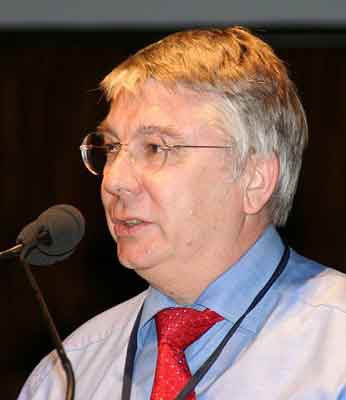.
Rainer Blatt

Rainer Blatt (*)
Rainer Blatt (born 8 September 1952) is a German-Austrian experimental physicist. His research centres on the areas of quantum optics and quantum information. He and his team were the first to teleport atoms.
Biography
Rainer Blatt graduated in physics from the University of Mainz in 1979. He finished his doctorate in 1981 and worked as research assistant in the team of Günter Werth. In 1982 Blatt received a research grant of the Deutsche Forschungsgemeinschaft (DFG) to go to the Joint Institute for Laboratory Astrophysics (JILA), Boulder, and work with John L. Hall (Nobel Prize winner 2005) for a year. In 1983 he went on to the Freie Universität Berlin, and in the following year joined the working group of Peter E. Toschek at the University of Hamburg. After another stay in the US, Rainer Blatt applied to qualify as a professor by receiving the “venia docendi” in experimental physics in 1988. In the period from 1989 until 1994 he worked as a Heisenberg research fellow at the University of Hamburg and returned several times to JILA in Boulder. In 1994 he was appointed to a chair in physics at the University of Göttingen and in the following year he was offered a chair in experimental physics at the University of Innsbruck. Blatt has headed the Institute for Experimental Physics ever since and is a member of the academic senate. Since 2003 Blatt has also held the position of Scientific Director at the Institute for Quantum Optics and Quantum Information (IQOQI) of the Austrian Academy of Sciences (ÖAW). Rainer Blatt is married, with three children.
Research
Experimental physicist Rainer Blatt has carried out trail-blazing experiments in the fields of precision spectroscopy, quantum metrology and quantum information processing. He works with atoms caught in ion traps which he manipulates using laser beams. This work is based on suggestions made in the mid-1990s by theorists Ignacio Cirac and Peter Zoller.[1] In 2004, using their suggested set-up, Blatt’s working group succeeded for the first time in transferring the quantum information of one atom in a totally controlled manner onto another atom (teleportation). The science journal Nature reported the experiment and gave it pride of place on the cover.[2] In that experiment three particles had been positioned in an ion trap. Two years later, Rainer Blatt’s working group already managed to entangle up to eight atoms in a controlled manner.[3] Creating such a first “quantum byte” (qubyte) is a further step on the way towards a quantum computer. Blatt is also known for his support of young scientists. Four of his former assistants (Christoph Becher, Jürgen Eschner, Dietrich Leibfried, Ferdinand Schmidt-Kaler) have since been appointed to chairs at universities abroad.
Awards
In 2007 Rainer Blatt and his European project partners were nominated by the European Commission for the Descartes Prize. In 2006 he received the Schrödinger Prize of the Austrian Academy of Sciences. In 1997 he won the Innovations Award of the Tiroler Sparkasse for new ideas on quantum information processing. Rainer Blatt is corresponding member of the Austrian Academy of Sciences.
References
1. ^ J.I. Cirac, P. Zoller, Quantum Computations with Cold Trapped Ions, Phys. Rev. Lett. 74 20, 4091–4094 (1995)
2. ^ M Riebe, H Häffner, CF Roos, W Hänsel, J Benhelm, GP Lancaster, TW Körber, C Becher, F Schmidt-Kaler, DF James, R Blatt. Deterministic quantum teleportation with atoms. Nature 429, 734 (2004)
3. ^ H Häffner, W Hänsel, CF Roos, J Benhelm, D Chek-al-Kar, M Chwalla, T Körber, UD Rapol, M Riebe, PO Schmidt, C Becher, O Gühne, W Dür, R Blatt. Scalable multiparticle entanglement of trapped ions. Nature 438, 643 (2005)
Works
* Rainer Blatt: Quantum information processing: Dream and Realization, in: Jürgen Audretsch (Ed.): Entangled World: The Fascination of Quantum Information and Computation. Wiley 2006 ISBN 978-3-527-40470-4
Links
* Biography Rainer Blatt
* Quantum Optics and Spectroscopy Group
Institute for Experimental Physics, University of Innsbruck
Institute for Quantum Optics and Quantum Information (IQOQI)
Retrieved from "http://en.wikipedia.org/"
All text is available under the terms of the GNU Free Documentation License

